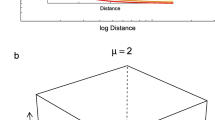Summary
Based on the constraints of the ballistic mechanism, we suggest that plants that utilize explosive dispersal are either maximizing ballistic distances or maximizing secondary dispersal (and thus are ballistically short-distance dispersers). Explosive seed dispersal of seven plant species was investigated in terms of factors contributing to the distance that seeds are thrown. As predicted, the long distance dispersers (4 species) showed more constancy in distance that seeds were thrown relative to the ballistically short-distance dispersers (3 species). The distribution of explosively dispersed seeds in terms of a resource for post-dispersal predators was evaluated by computer simulation. The results indicated that seed predation is unlikely to contribute to maximizing seed dispersal distance. A model for explosive seed dispersal was developed, based on the constraints of such dispersal. Long-distance dispersers were expected to use small, closely-spaced patches or to use large patches in which inbreeding depression or competition selects for maximal dispersal distances. Short-distance dispersers were expected to use small, widely-spaced patches where ballistic dispersal in itself is an inadequate means to disperse seeds, or to use large patches in which there is no premium for dispersal distance. Preliminary evidence supported the model.
Similar content being viewed by others
References
Arnold RM (1981) Population dynamics and seed dispersal of Chaenorrhinum minus on railroad cinder ballast. Am Midl Nat 106:80–91
Barr AJ, Goodnight JH, Sall JP, Blair WH, Chilko DM (1979) SAS user's guide. SAS Inst. Raleigh
Beattie AJ, Culver DC (1981) The guild of myrmecochores in the herbaceous flora of West Virginia forests. Ecology 62:107–115
Beattie AJ, Lyons N (1975) Seed dispersal in Viola (Violaceae): adaptations and strategies. Am J Bot 62:714–722
Comins HN, Hamilton WD, May RM (1980) Evolutionary stable dispersal strategies. J Theor Biol 82:205–230
Culver DC, Beattie AJ (1978) Myrmecochory in Viola: dynamics of seed-ant interactions in some West Virginia species. J Ecol 66:53–72
Harper JL (1977) Population biology of plants. Academic Press, London
Harper JL, Lovell PH, Moore KG (1970) The shapes and sizes of seeds. Ann Rev Ecol Syst 1:327–356
Janzen DH (1969) Seed-eaters versus seed size number, toxicity and dispersal. Evolution 23:1–27
Janzen DH (1970) Herbivores and the number of tree species in tropical forests. Am Nat 104:501–528
Leverich WJ, Levin DA (1979) Age-specific survivorship and reproduction in Phlox drummondii. Am Nat 113:881–903
Levin DA (1978) Genetic variation in annual phlox: self-compatible versus self-incompatible species. Evolution 32:245–263
Levin DA, Kerster HW (1968) Local gene dispersal in Phlox. Evolution 22:130–139
Levin DA, Kerster HW (1974) Gene flow in seed plants. Evol Biol 7:139–220
Lucas JR (1982) The biophysics of pit construction by antlion larvae (Myrmeleon, Neuroptera). Anim Beh 30:651–664
Price MV, Waser NM (1979) Pollen dispersal and optimal outcrossing in Delphinium nelsoni. Nature (Lond) 277:294–297
Ridley HN (1930) The dispersal of plants throughout the world. Reeve, Kent
Schemske DW (1978) Evolution of reproductive characteristics in Impatiens (Balsaminaceae): the significance of cleistogamy and chasmogamy. Ecology 59:596–613
Southwood TRE (1978) Ecological methods, 2nd ed. Chapman & Hall, London
Swaine MD, Dakubu T, Beer T (1979) On the theory of explosively dispersed seeds: a correction. New Phytol 82:777–781
Waller DM (1980) Environmental determinants of outcrossing in Impatiens capensis (Balsaminaceae). Evolution 34:747–761
Author information
Authors and Affiliations
Rights and permissions
About this article
Cite this article
Stamp, N.E., Lucas, J.R. Ecological correlates of explosive seed dispersal. Oecologia 59, 272–278 (1983). https://doi.org/10.1007/BF00378848
Received:
Issue Date:
DOI: https://doi.org/10.1007/BF00378848




